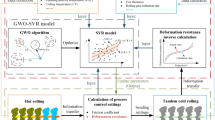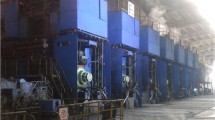Abstract
The roll deformation model of the six-high rolling mill is one of the core models of the strip shape control theory. The influence function method (IFM) is a numerical method applied to solve the roll deformation problem. This study aims to address the problems of slow calculation speed and insufficient calculation accuracy of IFM in calculating the roll deformation of the six-high rolling mill. Three optimization measures are proposed, namely, optimizing the iterative calculation order of the roll deformation to improve the calculation efficiency; introducing the Adam (Adaptive Moment Estimation) gradient descent optimization algorithm to enhance the stability of the iterative process; and introducing a high-precision rolling force model based on the XGBoost (eXtreme Gradient Boosting) algorithm to improve the calculation accuracy of flatness in the IFM. Parallel experimental results show that by applying the three optimization measures simultaneously, improving the iterative calculation order of the roll deformation can improve the calculation speed by about 7.64 times; introducing the Adam algorithm can reduce the oscillation range of roll contact pressure by an average of 50.4%, increasing the stability of the calculation process; and introducing a high-precision rolling force model based on the XGBoost algorithm can improve the flatness calculation accuracy by about 39.1%. This study provides an effective method to improve the calculation speed and accuracy of the roll deformation in a six-high rolling mill, which has important academic application value.












Similar content being viewed by others
Data availability
All data generated or analyzed during this study are included in this manuscript.
Code availability
Not applicable.
Abbreviations
- W, I, B :
-
Work roll, intermediate roll, support roll
- L, R :
-
Left, right
- F W, F I :
-
Work roll bending force and intermediate roll bending force
- A:
-
Unit column vector, A = [111…1]T
- P L, P R, P :
-
The vector of rolling force of the work roll on the left side, right side, and overall
- Y WL, Y WR, Y W :
-
The elastic bending of the work roll on the left side, right side, and overall
- Y IL, Y IR, Y I :
-
The elastic bending of the intermediate roll on the left side, right side, and overall
- Y BL, Y BR, Y B :
-
The elastic bending of the support roll on the left side, right side, and overall
- Q WIL, Q WIR, Q WI :
-
The vector of contact pressure between the work roll and the intermediate roll on the left side, right side, and overall
- Q IBL, Q IBR, Q IB :
-
The vector of contact pressure between the intermediate roll and the support roll on the left side, right side, and overall
- G WL, G WR :
-
The influence function matrix of the bending on the left and right sides of the work roll
- G IL, G IR :
-
The influence function matrix of the bending on the left and right sides of the intermediate roll
- G BL, G BR :
-
The influence function matrix of the bending on the left and right sides of the support roll
- G FWL, G FWR :
-
The influence function matrix of bending roll force on the left and right sides of the intermediate roll
- G IWL, G IWR :
-
The influence function matrix of bending roll force on the left and right sides of the intermediate roll
- Y WI, Y IB, Y WS :
-
The elastic flattening between the work roll and the intermediate roll, elastic flattening between the intermediate roll and the backup roll, and elastic flattening of the work roll caused by rolling force
- G WI, G IB, G WS :
-
The influence function matrix of elastic flattening between the work roll and the intermediate roll, influence function matrix of elastic flattening between the intermediate roll and the backup roll, and influence function matrix of elastic flattening of the work roll caused by rolling force
- M W, M I, M B :
-
The curvature vector of the work roll, intermediate roll, and backup roll
- Y WI 0, Y IB 0, Y WS 0 :
-
YWI, YIB, and YWS located at the center of the strip
- H, H C :
-
Strip thickness vector after rolling, half of the thickness at the center point of the strip
References
Wang DC, Liu HM, Liu J (2017) Research and development trend of shape control for cold rolling strip. Chin J Mech Eng 30:1248–1261. https://doi.org/10.1007/S10033-017-0163-8
Wei Z, Wang QL, Sun J, Peng W, Zhang DH (2023) Edge drop control characteristics of the taper-work roll contour for six-high cold mill. Int J Adv Manuf Technol 126:3615–3635. https://doi.org/10.1007/s00170-023-11339-8
Jin X, Li CS, Wang Y, Li X, Gu T, Xiang YG (2020) Multi-objective optimization of intermediate roll profile for 6-high cold rolling mill. Metals 10:287–309. https://doi.org/10.3390/met10020287
Stone MD, Gray R (1965) Theory and practical aspects in crown control. Iron Steel Eng 42:73–83
Zhou H, Bai JL (2014) Rolling force calculation for strip cold rolling based on influence function method. Appl Mech Mater 633–634:791–794. https://doi.org/10.4028/www.scientific.net/AMM.633-634.791
Wang Y, Li CS, Peng LG, An RD, Jin X (2021) Application of convolutional neural networks for prediction of strip flatness in tandem cold rolling process. J Manuf Process 68:512–522. https://doi.org/10.1016/j.jmapro.2021.05.062
Wang QL, Sun J, Li X, Wang Z, Wang PF, Zhang DH (2020) Analysis of lateral metal flow-induced flatness deviations of rolled steel strip Mathematical modeling and simulation experiments. Appl Math Model 77:289–308. https://doi.org/10.1016/j.apm.2019.07.036
Wang PF, Zhang DH, Li X, Liu JW, Wang JS (2012) Research and application of non-symmetrical roll bending control of cold rolling mill. Chin J Mech Eng 25(1):122–127. https://doi.org/10.3901/CJME.2012.01.122
Wang QL, Sun J, Li X, Liu YM, Wang PF, Zhang DH (2018) Numerical and experimental analysis of strip cross-directional control and flatness prediction for UCM cold rolling mill. J Manuf Process 34:637–649. https://doi.org/10.1016/j.jmapro.2018.07.008
Abdelkhalek S, Zahrouni H, Legrand N, Potier-Ferry M (2015) Post-bucking modeling for strips under tension and residual stresses using asymtotic numerical method. International Journal of Mechanical Science 104:126–137. https://doi.org/10.1016/j.ijmecsci.2015.10.011
He HN, Shao J, Wang XC, Yang Q, Liu Y, Xu D, Sun YZ (2021) Research and application of approximate rectangular section control technology in hot strip mills. J Iron Steel Res Int 28(3):279–290. https://doi.org/10.1007/s42243-021-00558-6
Shohet KN, Townsend NA (1971) Flatness control in plate rolling. J Iron Steel Inst 209:769–775
Edwards WJ (1973) Analysis of strip shape, automation of tandem mills. The Metals Society 176. https://cir.nii.ac.jp/crid/1571980074031973248
Ataka M (2015) Rolling technology and theory for the last 100 years: the contribution of theory to innovation in strip rolling technology. ISIJ Int 55(1):89–102. https://doi.org/10.2355/isijinternational.55.89
Wang Y, Li CS, Jin X, Xiang YG, Li XG (2020) Multi-objective optimization of rolling schedule for tandem cold strip rolling based on NSGA-II. J Manuf Process 60:257–267. https://doi.org/10.1016/S1006-706X(10)60167-7
Xu JZ, Gong DY, Liu XH (2004) Model building of backup roller diameter effect rate in 4-high mill. J Mater Sci Technol 20(4):454–456. https://api.semanticscholar.org/CorpusID:107994350
Liang XG (2014) Bending roll force setting model for six-roll cold tandem mill. Iron Steel 49(10):40–43+50. http://www.chinamet.cn/Jweb_gt/CN/10.13228/j.boyuan.issn0449-749X.20140218
Li X, He AR, Liu C (2018) A rapid calculation method for predicting roll deformation of six-high rolling mill. J Iron Steel Res Int 25:901–909. https://doi.org/10.1007/s42243-018-0131-2
Kingma D, Ba J (2014) Adam: a method for stochastic optimization. Comput Sci. https://doi.org/10.48550/arXiv.1412.6980
Jü SRA (2015) Deep learning in neural networks: an overview. Neural Netw 61:85–117. https://doi.org/10.1016/j.neunet.2014.09.003
Chen TQ, Guestrin C (2016) XGBoost: a scalable tree boosting system. Proceedings of the 22nd ACMSIGKDD International Conference on Knowledge Discovery and Data Mining. https://doi.org/10.1145/2939672.2939785
Nguyen MH, Nguyen TA, Ly HB (2023) Ensemble XGBoost schemes for improved compressive strength prediction of UHPC. Structures 57:105062. https://doi.org/10.1016/j.istruc.2023.105062
Langlands TAM, Mcelwain DLS, Domanti SA (2004) An approximate method for the solution of an influence function foil rolling model. Int J Mech Sci 46(8):1139–1156. https://doi.org/10.1016/j.ijmecsci.2004.08.006
Yann L, Yoshua B, Geoffrey H (2015) Deep learning. Nature 521:436–444
Wang C, Deng C, Wang S (2020) Imbalance-XGBoost: leveraging weighted and focal losses for binary label-imbalanced classification with XGBoost. Pattern Recogn Lett 136(25):190–197. https://doi.org/10.1016/j.patrec.2020.05.035
Chen YF, Peng LG, Wang Y, Zhou YL, Li CS (2023) Prediction of tandem cold-rolled strip flatness based on Attention-LSTM model. J Manuf Process 91:110–121. https://doi.org/10.1016/j.jmapro.2023.02.048
Chen YF, Peng LG; Feng PJ, Zhou YL; Li CS (2023) Optimization of multi-segment work roll profile for 1340mm HC tandem cold rolling mills based on DBSCAN and NSGA-II algorithm. Steel Res Int 94. https://doi.org/10.1002/srin.202300077
Funding
This work was supported by the Natural Science Foundation of Liaoning Province (Grant No. 2020-MS-094). Moreover, the authors are very grateful to Yilin Zhou, chief engineer of the Cold Rolling Mill of Panzhihua Steel and Vanadium Co., Ltd., for providing production rolling data and suggestions.
Author information
Authors and Affiliations
Contributions
All authors contributed to the study conception. The manuscript has been written by all authors. All authors read and approved the final manuscript.
Corresponding authors
Ethics declarations
Ethics approval
This research compliance with ethical standards. All the people involved are aware of and agree to the publication of this article.
Consent to participate
All authors know and agree to be co-authors.
Consent for publication
All authors agree to publish.
Conflicts of interest
The authors declare no competing interests.
Additional information
Publisher's Note
Springer Nature remains neutral with regard to jurisdictional claims in published maps and institutional affiliations.
Rights and permissions
Springer Nature or its licensor (e.g. a society or other partner) holds exclusive rights to this article under a publishing agreement with the author(s) or other rightsholder(s); author self-archiving of the accepted manuscript version of this article is solely governed by the terms of such publishing agreement and applicable law.
About this article
Cite this article
Chen, Y., Feng, P., Zhou, J. et al. An improved method for calculating roll deformation of six-high rolling mill: enhances computation speed and accuracy. Int J Adv Manuf Technol 130, 3755–3770 (2024). https://doi.org/10.1007/s00170-024-12950-z
Received:
Accepted:
Published:
Issue Date:
DOI: https://doi.org/10.1007/s00170-024-12950-z




